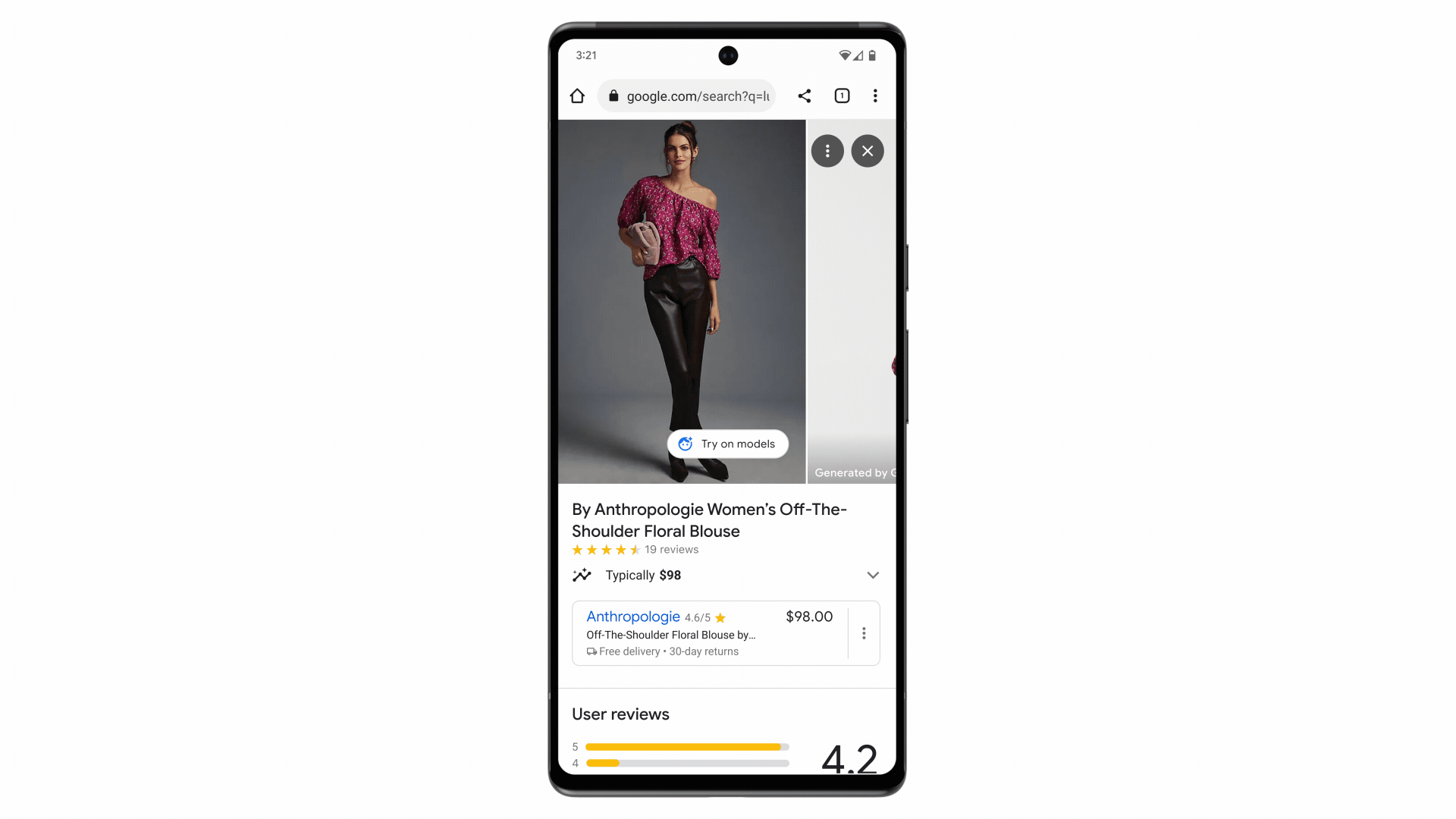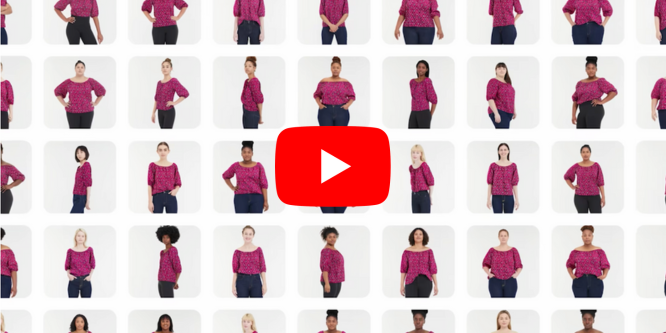
Image Source: Google
Is Generative AI A Game-Changer For Virtual Apparel Try-On?
Google has introduced a virtual try-on tool for apparel, tapping generative artificial intelligence (AI) that it believes is leaps ahead of avatar- or photo-upload-driven try-on models.
Google photographed people ranging in sizes from XXS to 4XL across different skin tones, body shapes, ethnicities and hair types to create a diffusion-based neural network.
The diffusion process gradually adds extra pixels, or “noise,” to an image until it becomes unrecognizable, then removes the noise until the original image is reconstructed. Unlike traditional diffusion methods that rely on text input, Google’s approach pairs two images: the garment against a person.
“Each image is sent to its own neural network (a U-net) and shares information with each other in a process called ‘cross-attention’ to generate the output: a photorealistic image of the person wearing the garment,” said Ira Kemelmacher-Shlizerman, Google’s senior staff research scientist, Shopping, in a blog entry.

Google’s Shopping Graph, which has about 40 billion product listings, then trains the AI model using millions of random images of different garments on people in varied poses.
Google’s AI-driven virtual try-on model “can take just one clothing image and accurately reflect how it would drape, fold, cling, stretch and form wrinkles and shadows on a diverse set of real models in various poses,” Lilian Rincon, Google’s senior director of product, Shopping, said in a separate blog entry.
Select apparel from H&M, Loft, Everlane, and Anthropologie is currently accessible to customers through a “Try On” badge at Google’s shopping search.
Mr. Kemelmacher-Shlizerman sees limitations in virtual try-on techniques like geometric warping that can cut and paste and then deform a clothing image to fit a silhouette. “Clothes don’t realistically adapt to the body, and they have visual defects like misplaced folds that make garments look misshapen and unnatural,” he said.
Walmart last year launched a technology enabling online shoppers to see how their apparel selections looked via a selected avatar as well as through an uploaded photo of themselves. Denise Incandela, EVP, Apparel and Private Brands, Walmart U.S., said at the time, “We believe the largest and closest store to our customers is the one in their pockets.”
Discussion Questions
DISCUSSION QUESTIONS: Does generative AI have the potential to replicate the sensation of trying on clothes in physical fitting rooms? Is AI-driven online try-on of apparel likely an advance over shoppers choosing their personalized avatars or uploading photos of themselves?



Let’s start with Captain Obvious: currently, nothing can replace the feeling of physically trying on clothing in a fitting room (at least not yet). GAI will not be a game changer when compared against the technology that’s available today. It’s incredibly cool and will definitely attract attention but it won’t move the needle in the fitting battle (not yet). However, everything today is AI enabled so have at it. In fact, I saw an umbrella at a store the other day that was powered by AI. Imagine what Mary Poppins could have done with one of those?
Clothing shoppers tend to leave PDPs (product detail pages) to search social media to find people wearing the items. Of course this leads to lots of abandoned carts and lost sales. Bringing user generated content (UGC) into the brand’s PDP is a better approach.
Using generative AI might work for predicting fit, but it will have to be a very fast process from uploading a selfie to seeing the item on “you.” Privacy issues, too. And I predict the same tendency to go look on social as well. Increased sales, decreased returns, and satisfied customers are the KPI goals here, and my vote is for real people (UGC) over AI until Google can prove otherwise.
Also, UGC is probably “stickier” than GAI and includes the elements of social proof and authenticity. Gen Z shoppers in particular have a sixth sense for lack of authenticity. Why use AI to guess how an item might look on you when UGC can show real people, your size, wearing it in real life?
AI will make virtual try-on more sophisticated and that’s a good thing for helping people understand what products might look like on them and, thereby, potentially reducing returns. However, it does not completely replace in-person try on because it cannot replication sensations: the feel of the fabric, the way a garment makes you feel, how it responds as you move, and so on. AI has lots of great applications but it contains the word ‘artificial’ for a reason – it’s not a complete replacement for real life!
While these are advancements, I’m still skeptical of any type of virtual try-on because it often focuses on the technology, rather than the psychological experience of trying on clothes (and fashion/personal style overall). We’re all guilty of trying on a medium when we know we may be a large – so will the app show how tight it looks when you put it on? What about pants that don’t button – does it tell you they are too small, or show you how they won’t fit? And what’s the impact of that psychologically and consumers’ likelihood to continue to use virtual try-on? Tactically, there’s also enough inconsistency in sizing by brand and even by each individual item to guarantee that what you’ll get in the mail fits as promised.
This sounds good on paper but the proof will be in the actual customer experience. Virtual fitting rooms for me were never accurate.
Every body is different and changing sizes requires more than making a garment larger or smaller.
AI driven online try-on is much more attractive than uploading a photo of yourself because who wants that floating online forever?
Have I bought a pair of sunglasses based on a virtual fitting room experience? Yes. Would I buy clothes from a brand I’d never bought or in a style I’d never bought before? No. I wouldn’t trust that the pants won’t gape at the back, or be too tight in the wrong places. In order to train an AI to do this well, I believe you need more than pictures. You need hard measurements / attribute data and you need to understand individual customer preferences. What feels too tight on one person might feel totally fine on another. The virtual experience still needs work. However, if it drives down your return rate, it could be worth doing. But if virtual try ons don’t get it right, you’ll end up with an increase in returns – which is very expensive.
I may be too much of a garmento to be objective about AI replicating the fitting room experience. Fit is about a lot more than math and measurements. It’s about fabric hand-feel, texture, weight, and drape. How does 10 ounce denim feel versus 12 ounce denim? How does 2 percent stretch feel versus 3 percent? I have no doubt that AI will help move the needle in on-line fit evaluation. Let’s see what happens to the return rate.
Disclaimer: I have been building AI solutions for over a decade.
There really is no need to talk about the simulation technique being used. It’s in fashion at the moment to have some commentary on LLMs or generative AI to catch the SERPs. Not one person is going to understand the technology, care about it, or make an analysis of different modeling techniques. For shoppers or pundits, it’s simply a matter of the visual result.
And that’s the point with some critiques of virtual try on. It’s a visual representation. It’s not wearing the real garment. For those that want to purchase clothes online, it’s more useful to see themselves in the digital garment than a model who’s body differs from theirs. If the colors look good on a shopper’s simulation and it’s a style they think can work for them, they can risk buying without trying or head to a store with a focused shopping list based on their simulated try-ons to truly check the fit.
On a physical level, replicating sensations requires haptics, not GAI. If the question is, “Can GAI so closely mimic a physical try on,” then the answer is, “No.” At least not yet. If I’m buying a pair of jeans I don’t want to know they look on a digital model, I want to know how they look and — more importantly — feel on me. “Fit” is a matter of generally subjective personal perception. How many of us have walked down a street and passed a person and thought, “Do they really think they look good in that?” GAI can’t solve for the irrational. Is this a step forward? We’ll see. But, if it is, it’s, at best, a baby step. Digital “try ons” will get there one day, it just won’t be today.
No sale is complete until it is on a body. Period. You’re kidding yourself to think this solves returns.
Nothing will ever completely replicate actually putting something on, regardless of how great the images are. However, I believe this technology will allow for some incremental improvement in the online shopping experience, and it will keep getting better, AND it will provide financial benefits in the form or fewer returns. But competely replace? Nope.
I would love to compare what the image comes back as and what I actually look like. Product fabrication also plays a huge impact, which makes me wonder if that’s at all considered in the modeling. Leather, for example, does not give and take the same way that a larger cotton dress would.